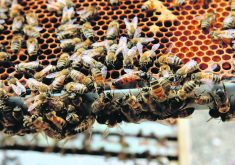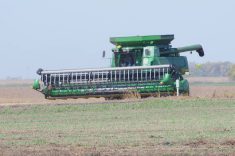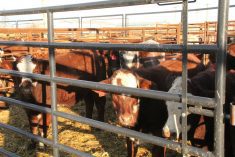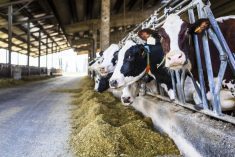There would be both winners and losers if the world followed Tim McAllister’s advice on how to lower greenhouse gas emissions from methane-belching bovines.
“If we really wanted to reduce emissions we should be looking at identifying which areas in the world can produce ruminant products with the least amount of emissions and focusing production globally there,” said McAllister, a principal research scientist of ruminant nutrition and microbiology, from the Lethbridge Research Centre.
Canada would come out a winner because grain-fed cattle are more efficient at producing meat, which lowers the amount of emissions per kg of meat produced, he said.
Read Also

Pig transport stress costs pork sector
Popular livestock trailer designs also increase pig stress during transportation, hitting at meat quality, animal welfare and farm profit, Agriculture and Agri-Food Canada researcher says
However, producers in other regions of the world would likely protest and it’s unlikely any nation would willingly give up their livestock industries.
McAllister proposes instead that producers adopt emissions abatement technology — and that they be given an economic incentive to do so.
“As it stands today there is no direct payment for lowering greenhouse gas emissions from cow production in Canada,” he said. “So anything that has to be introduced as a result of a change in production practices has to have economic viability as well.”
Carbon
Tropical countries, like Brazil, which is the largest beef exporter in the world, are able to experiment with techniques like carbon sequestration. Western Canadian producers could also sequester carbon if they took cropland out of production and turned it into perennial forage or grassland.
Trading grain diets for forage would have its own environmental impact though.
“Cattle out on pasture would emit more methane per unit of meat produced,” said McAllister. “And that’s a change not very likely to occur in the future because the economic incentive is not there.”
The livestock sector contributes an estimated 7.1 gigatonnes of carbon dioxide every year — that’s 14.5 per cent of all human-induced emissions. Beef production accounts for 41 per cent of those greenhouse gases.
When it comes to sustainability there is more than just greenhouse gases though.
Bigger picture
McAllister said it is also important to consider the importance of biodiversity, water conservation, eutrophication and acidification.
“I think we need to think beyond greenhouse gases when it comes to beef cattle production and really look at a systemic type of approach that considers all aspects of the production system and the contribution that it makes to society and the environment as a whole.”
Greenhouse gases are easier to measure and that is why they have been targeted. Though there are no direct payment programs in Canada, some provinces are experimenting with incentive programs.
Alberta has a Conservation Cropping Protocol, through the federal government, where producers can earn “carbon offset” credits by adopting zero-till management, which increases soil carbon levels, reducing greenhouse gas emissions.
McAllister said there are also protocols in place to reward producers who add oil to their cattle’s diet, but not many farmers are adopting this practice since the cost of the oils currently outweighs the incentives.
“As a result, even though we know oils can lower methane emissions there is very little added to the beef cattle diets in Canada,” he said. Oil-enriched diets have the added bonus of also increasing the animal’s energy levels.
As the world’s population grows — projected to reach 9.5 billion by the year 2050 — and the amount of available farmable land continues to be limited, McAllister said, we will need to make some changes.
“We’re going to have to produce more meat on less land if we’re going to meet future requirements. That’s obviously going to lead to an increase in greenhouse gas emissions as well, because as we have more livestock we’re going to have more emissions.”




















